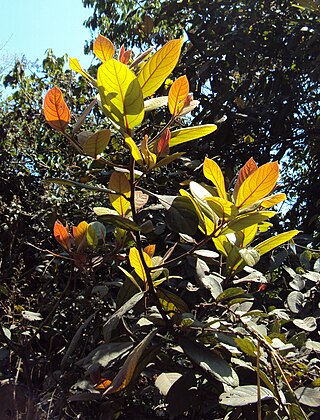
Lauraceae, or the laurels, is a plant family that includes the true laurel and its closest relatives. This family comprises about 2850 known species in about 45 genera worldwide. They are dicotyledons, and occur mainly in warm temperate and tropical regions, especially Southeast Asia and South America. Many are aromatic evergreen trees or shrubs, but some, such as Sassafras, are deciduous, or include both deciduous and evergreen trees and shrubs, especially in tropical and temperate climates. The genus Cassytha is unique in the Lauraceae in that its members are parasitic vines. Most laurels are highly poisonous.

Cryptocarya is a genus of evergreen trees belonging to the laurel family, Lauraceae. The genus includes more than 350 species, distributed through the Neotropical, Afrotropical, Indomalayan, and Australasian realms.

Cryptocarya agathophylla is a member of the laurel family, Lauraceae, and originates in Madagascar.
Beilschmiedia bancroftii is a tree species in the family Lauraceae. It is native to Queensland in Australia. Common names include yellow walnut, yellow nut and canary ash.

Cryptocarya bidwillii, the yellow laurel, is a small to medium-sized tree in the laurel family. Occurring in Australian rainforests from Nymboida in the state of New South Wales to Townsville in tropical Queensland. Often found in the dryer ridges in dry rainforest or in viney scrubs.

Chaetocneme porphyropis, the purple brown-eye or purple dusk-flat, is a species of butterfly of the family Hesperiidae endemic to tropical Queensland, between Innisfail and Daintree on the Atherton Tableland. Its wingspan is about 60 mm. The larvae feed on various Lauraceae species, including Cinnamomum camphora, Cryptocarya grandis, Endiandra compressa, Litsea leefeana, and Neolitsea dealbata.
Aspidostemon is a genus of flowering plants belonging to the family Lauraceae. It occurs in Madagascar.
Cryptocarya ferrarsi is a species of small forest tree in the family Lauraceae. It is endemic to the Middle Andaman Island of India.
Rose walnut is a common name for several flowering plants in the family Lauraceae, in a different family and order from true walnut trees, and may refer to:
Rose maple is a common name for several flowering plants in the family Lauraceae, in a different family and order from true maples, and may refer to:
Cryptocarya elegans is a species of trees in the family Lauraceae. The species native range is the Samoa islands.
Yasunia is a genus of flowering plants in the family Lauraceae, found in Ecuador and Peru. Yasunia appears to be nested within Beilschmiedia.

Cryptocarya corrugata is a species of tree in the family Lauraceae. Found in tropical rainforest in Queensland in Australia, this species may grow to 35 metres tall. It was collected by William Francis west of Mackay in the Eungella range in 1922. The fruit is eaten by cassowaries and fruit pigeons.

Cryptocarya vulgaris is a species of shrub in the family Lauraceae. Found in tropical rainforest in Queensland in Australia, this species may grow to 6 metres tall.

Cryptocarya cunninghamii is a tree in the family Lauraceae. Found in protected sites and rainforest in northern Australia, the coconut laurel has an aromatic scent, and attracts birds and butterflies.

Cryptocarya anamalayana is a rare rainforest tree endemic to the southern Western Ghats, India. The specific epithet of the name refers to the Anamalai Hills, a major area of its distribution. The species considered endangered under the IUCN Red List of Threatened Species.

Litsea wightiana is a species of plant in the family Lauraceae. It is a tree which grows 10 to 20 metres tall. It is endemic to Western Ghats of India, in the states of Tamil Nadu, Maharashtra, Kerala, and Karnataka. It grows in evergreen and semi-evergreen montane forests from 1,000 to 2,400 metres elevation.
Cryptocarya turbinata is a species of flowering plant in the laurel family, Lauraceae. It is a tree native to Fiji, Niue, the Samoan Islands, Tonga, and Vanuatu.

Cryptocarya elliptifolia is a species of small evergreen tree in the family Lauraceae. It is native to the Philippines and Orchid Island in Taiwan. It is classified as Critically Endangered by the IUCN Red List of Threatened Species.












